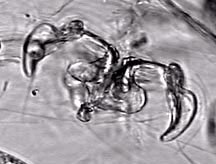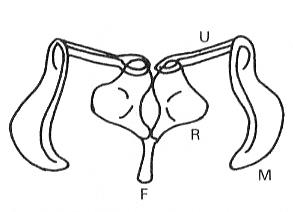The Rotifer Jaw
by Mike Morgan, UK.
February 1998
 The following may be of interest, whilst observing
a sample of pond water, I found a good example of the jaws of a
rotifer (Brachionus). The mouth of the rotifer leads to
the pharynx which contains the jaws or trophi. The jaws consist
of seven, hard cuticularized parts, which retain their shape
after death or compression, though not necessarily their relative
positions.
The following may be of interest, whilst observing
a sample of pond water, I found a good example of the jaws of a
rotifer (Brachionus). The mouth of the rotifer leads to
the pharynx which contains the jaws or trophi. The jaws consist
of seven, hard cuticularized parts, which retain their shape
after death or compression, though not necessarily their relative
positions.
 The
basic constituents of the jaw are one fulcrum, and a pair each of
unci, rami and manubria. There are several jaw types: malleate,
incudate, virgate, uncinate, ramate and malleoramate. The type of
jaw observed forms the basis for division into families.
The
basic constituents of the jaw are one fulcrum, and a pair each of
unci, rami and manubria. There are several jaw types: malleate,
incudate, virgate, uncinate, ramate and malleoramate. The type of
jaw observed forms the basis for division into families.
Key:
F fulcrum; M manubrium; R ramus; U uncus.
The easiest jaw type to recognize, and shown here, is the
malleate type, which is characteristic of the Brachionidae. All
parts of the jaw are well developed and strong. The fulcrum is
short and the rami broad. The unci have ridges across the surface
terminating in teeth at the inner edge. The action of the jaw is
to cut and chew, between the teeth, particles collected.
Comments to the author Mike
Morgan welcomed.
Image notes:
Ventral View, in both videoed image and diagram are the jaws of Brachionus
calyciflorus.
References:
Life in a Drop of Pond Water (The Rotifera) Mike Morgan
With thanks to Rosalind
Pontin for permission to use text and illustration from her book
'A Key to British Freshwater Planktonic Rotifera'.
© Microscopy UK
or their contributors.
Please report any
Web problems to the Micscape Editor.
Micscape is the
on-line monthly magazine of the Microscopy UK Web site at
http://www.microscopy-uk.net
WIDTH=1
© Onview.net Ltd, Microscopy-UK, and all contributors 1995 onwards. All rights
reserved. Main site is at www.microscopy-uk.org.uk with full mirror at www.microscopy-uk.net.
 The following may be of interest, whilst observing
a sample of pond water, I found a good example of the jaws of a
rotifer (Brachionus). The mouth of the rotifer leads to
the pharynx which contains the jaws or trophi. The jaws consist
of seven, hard cuticularized parts, which retain their shape
after death or compression, though not necessarily their relative
positions.
The following may be of interest, whilst observing
a sample of pond water, I found a good example of the jaws of a
rotifer (Brachionus). The mouth of the rotifer leads to
the pharynx which contains the jaws or trophi. The jaws consist
of seven, hard cuticularized parts, which retain their shape
after death or compression, though not necessarily their relative
positions. The
basic constituents of the jaw are one fulcrum, and a pair each of
unci, rami and manubria. There are several jaw types: malleate,
incudate, virgate, uncinate, ramate and malleoramate. The type of
jaw observed forms the basis for division into families.
The
basic constituents of the jaw are one fulcrum, and a pair each of
unci, rami and manubria. There are several jaw types: malleate,
incudate, virgate, uncinate, ramate and malleoramate. The type of
jaw observed forms the basis for division into families.